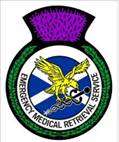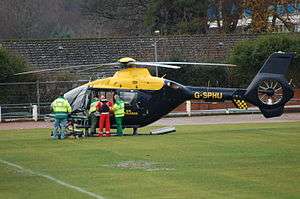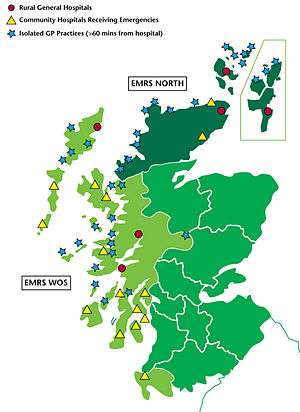Emergency Medical Retrieval Service
The Emergency Medical Retrieval Service (EMRS) provides aeromedical critical care to people in Scotland. It provides patients in remote and rural areas with rapid access to the skills of a consultant in emergency medicine, intensive care medicine, or anaesthesia, and facilitates transfers to larger, better equipped city hospitals. The team is available 24 hours a day with services provided in partnership with the Scottish Ambulance Service utilising both helicopters and fixed-wing aircraft. The service began operating in the West of Scotland in 2004 and has provided a national service since 2010. The EMRS now operate as part of ScotSTAR, the Scottish national retrieval service, sharing a bespoke base at Glasgow Airport.
| Emergency Medical Retrieval Service | |
|---|---|
 The crest of the EMRS | |
| Established | 2004 |
| Headquarters | Glasgow airport |
| NHS region | Scotland |
| Budget | £2 million |
| Website | www |
History
The EMRS was formed in 2004 when NHS Argyll and Clyde approved a 12-month trial which involved 11 consultants in emergency or intensive care medicine.[1] The EMRS were initially based at Glasgow City Heliport and operated only in the Argyll and Clyde area. Over the first 12 months the EMRS attended 40 patients.[2]
In 2007, the service was extended to cover three rural general hospitals and 13 community hospitals as part of an 18-month trial funded with £1.59 million.[3] The success of the service saw its operating zone expanded throughout the west coast of Scotland and the EMRS now operates from Stranraer in the south to Stornoway in the north.[4] An independent service evaluation demonstrated value for money and lifesaving benefits of critical care retrieval.[5]
In March 2010, the Scottish Government acknowledged that due to its continuing success, the service would be further enhanced by the addition of a second team, operational from October 2010.[6][7] The second team increased the number of participating consultants and Doctors from eight to fifteen.[8] In 2010, around 90% of EMRS activity involved secondary retrieval.[9] Annual running costs were now in the region of £2M.[10] In 2011, annual activity was estimated to be 324 transfers each year with around 60% of these by rotary wing and 35% by fixed-wing aircraft.[11]
In June 2014, EMRS teams began to routinely carry a stock of O negative blood to allow transfusion earlier when responding to emergencies.[12] During the period of the 2014 Commonwealth Games a third team of medics was available.[12]
As of December 2014, the staff of the service had expanded to include 27 part-time consultants and had completed more than 3,000 retrievals.[13]
In September 2015, the EMRS announced their move to a new purpose-built base, located at Glasgow Airport.[14]
Resources

In addition to responding by road the EMRS is supported by aircraft from the Scottish Ambulance Service's Air Ambulance Division, and the helicopters of the UK Coastguard.
Equipment
Collaboration with the Scottish National Blood Transfusion Service (SNBTS) allows the EMRS to have O-negative blood immediately available to take on all missions.[15]
The EMRS have developed a bespoke app to make their standard operating procedures available to clinicians.[16]
Background

The EMRS functions supplementary to the regular Scottish Ambulance Service Air Ambulance service. Unlike air ambulance services in other parts of the UK, both services are funded by the Scottish Government. The service responds to seriously ill and injured patients, often in remote locations, who require early critical care interventions and quick transfer to a better equipped, urban hospital.[17]
The EMRS have occasionally featured on the Channel 5 documentary series Highland Emergency, which charts the work of rescue services in the Scottish Highlands.[18]
Context
Many other countries with large populations in rural or inaccessible areas have developed similar schemes. For example, the Royal Flying Doctor Service of Australia operates on very similar lines to the EMRS. New Zealand and Canada have also developed similar patient retrieval services in support of their rural health care practitioners.
Awards
In March 2010, EMRS won the Secondary Care Team of the Year category in the BMJ awards for its work in “transforming the care and transfer of seriously ill and injured patients in remote and rural Scotland”.[19] This award recognised hospital teams that demonstrate improved outcomes of medical & surgical conditions.[20]
In 2012, the app developed by the EMRS won the EHI award for best use of mobile technology in healthcare and the NHS Scotland eHealth award for Best NHS Scotland use of Mobile technology.[16]
References
- Whitelaw, AS; Hsu, R; Corfield, A R; Hearns, S (January 2006). "Establishing a rural emergency medical retrieval service". Emergency Medicine Journal. 23 (1): 76–78. doi:10.1136/emj.2005.025528. PMC 2564140. PMID 16373814.
- Corfield, A R; Thomas, L; Inglis, A; Hearns, S (2006). "A rural emergency medical retrieval service: the first year". Emergency Medicine Journal. 23 (9): 679–683. doi:10.1136/emj.2006.034355. PMC 2564207. PMID 16921078.
- "Medical airlift service extended". BBC News. 25 June 2007.
- "History". Glasgow: EMRS. Archived from the original on 11 April 2009. Retrieved 18 November 2009.
- Boyle, John; Whyte, Russell; Dickson, Effie; Godden, David; Heaney, David; Munro, D. Alasdair (2010). Evaluation of the Emergency Medical Retrieval Service (PDF) (Report). Scottish Government.
- "'Flying doctor' scheme to expand". BBC News. 2 March 2010.
- "The flying doctors". BBC News. 29 April 2010.
- "Flying doctor service takes off across Scotland". BBC News. 25 October 2010.
- Corfield, Alasdair R; Adams, Jenny; Nicholls, Rachel; Hearns, Stephen (19 August 2010). "On-scene times and critical care interventions for an aeromedical retrieval service". Emergency Medicine Journal. 28 (7): 623–625. doi:10.1136/emj.2010.091421. PMID 20724465.
- "Flying doctors flying high" (Press release). Scottish Government. 2 March 2010. Retrieved 20 November 2015.
- "Towards a Single National Specialist Transport Service for Scotland - ScotSTAR: Strategic vision" (PDF). Scottish Government. 18 November 2011. p. 6. Retrieved 22 November 2015.
- Weldon, Victoria (12 June 2014). "Flying doctors add new team to cover Games emergencies". The Herald. Retrieved 23 November 2015.
- "Rural fast-response medics to be celebrated". The Scotsman. 3 December 2014. Retrieved 22 November 2015.
- "New Glasgow Airport base for patient retrieval team" (Press release). Glasgow Airport. 22 September 2015. Archived from the original on 23 November 2015. Retrieved 22 November 2015.
- "Blood on board" (Press release). Scottish National Blood Transfusion Service (SNBTS). 27 March 2015. Retrieved 12 December 2015.
- Walker, Natalie (22 October 2012). "Smartphone app to help rural healthcare wins two awards". The Scotsman. Retrieved 12 December 2015.
- "What we do". Glasgow: EMRS. Archived from the original on 11 April 2009. Retrieved 18 November 2009.
- "Spin Doctor (EMRS Newsletter)" (PDF). Glasgow: EMRS. January 2009. Retrieved 18 November 2009.
- "Q&A: Dr Stephen Hearns of EMRS". Medical and Dental Defence Union of Scotland (MDDUS). 30 June 2010. Retrieved 22 November 2015.
- "Secondary Care Team of the Year 2010". BMJ Group. Archived from the original on 22 May 2012.